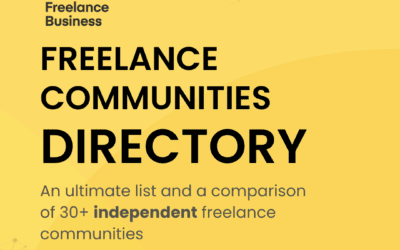As a fellow freelancer (in event management and marketing), I’ve grappled with the same questions about setting the right fees for my services. When I embarked on my freelance journey, I initially calculated my prices by factoring in my fixed expenses as a self-employed professional and added a margin for profitability.
Additionally, I conducted research to understand how much an agency charged for similar work, ensuring that my rates were competitive. My pitch to clients was straightforward: I offered high-quality services at a lower cost than an agency, thereby helping them save on marketing expenses. I positioned myself as an integral part of their team, not just another external agency. However, I soon realized that I may have been undervaluing my services.
Throughout my freelance career, my prices evaluated and doubled (or triple on some kind of services), I have also experimented with per hour rates and project fees and still use one of another depending on the situation. I’ve encountered varying perspectives on my fees, regardless of how high or low they were, with clients describing them as anywhere from “reasonable” to “CEO-level.” The challenge was understanding how to strike the right balance.
The frustration continued when I delved into annual reports published by freelance marketplaces. Many of these reports provided figures but lacked essential context, such as location, professional sector, seniority, and whether the freelancers were working full-time or part-time. This further complicated the process of determining appropriate fees.
So, how can you, as a freelancer, set the right fee for your services? Here are some thoughts to consider:
Look Beyond Benchmarks
Benchmark reports are informative tools, especially for HR professionals and recruiters seeking to gauge the cost of hiring a freelancer. However, as a freelancer, you shouldn’t view these benchmarks as strict price ceilings. While setting higher fees may deter some potential clients, it’s essential to recognize that not every job aligns with your pricing strategy.
Understand the Market
Various freelance fee reports such as the Payoneer 2022 Global Freelancer Income Report, which states that the worldwide average hourly freelance rate is $28 (24 EUR) – ouch – or Reports like YunoJune’s 2023 Freelancer Rates Report stating an average daily fee of 438 GBP (500 EUR) and Malt’s Freelancing in Europe 2022 provide insights into average daily fees in different regions and sectors ranging from 190 to 1000 EUR.
The data is highly dispersed and lacks clarity regarding how much freelancers should charge. It’s essential to bear in mind that these figures are frequently influenced by clients rather than freelancers. Rates are determined by clients based on various factors, which means they may not accurately represent the daily desired fee that a freelancer can command.
One of the most relevant resource we can recommend is Freelancing Female Rate Sheet, created by freelancers themselves.
Understand Your Role
Analyse whether you are a replacement resource for a business or an individual. If you are stepping into a role previously occupied by a business, you may negotiate with a departmental budget, providing more room for discussions. However, if you’re replacing an individual, your fees may be covered by the procurement or HR budget, offering fewer opportunities for negotiation.
Avoid Overcomplicating Pricing
While value-based pricing is often recommended, it may not be suitable for all freelancers, especially those who are new to the field. If you’re unsure how to assess the value you bring to a company, consider charging per day or per hour. For instance, in Europe (Belgium), €10 per hour is akin to what you might pay a cleaner or babysitter, while €80 could be the rate for an accountant, and €150 or more might be the fee for a lawyer. These are ballpark figures to help you gauge where your services may fall on the pricing spectrum.
Consider the Complexity
Tailor your pricing strategy to the complexity of the solutions you offer. For graphic designers, the complexity might vary from designing a one-off logo (low complexity) to a full rebranding project that involves multiple team members (high complexity). Likewise, in event management, tasks during an event are considered low complexity, while managing an entire event project involving various stakeholders falls under high complexity.
Another approach to tackle your price setting is actually to look at your financial situation more coherently. Here is what Robert Vlach, business consultant and founder of Freelancing.eu, Author of The Freelance Way suggested during the Freelance Business Month QA session on pricing.
Robert crafted his ‘pricing profile’ to illustrate how a range of seemingly unrelated factors influence his pricing decisions. This profile mirrors a more intricate process he employs when working with clients to evaluate their business and financial situation before arriving at any pricing decisions.
He has defined 6 ratios:
- Debts to Assets
- Financial reserves
- Pre-sold services
- Work availability
- Hourly rate in comparison to the industry average
- Pricing flexibility
— take a look here. You can define your own pricing profile and compare it to others here.
Another interesting way to determine whether your pricing aligns with what your freelance colleagues are charging is to take a sneak peek into Wethos. For about 10 EUR a month, you can get access to templates and pricing recommendations based on what other freelancers have charged for a similar scope of work. You can get 1 month for free if you register here.
Ultimately, pricing your freelance services is a nuanced process, and there’s no one-size-fits-all approach. Don’t hesitate to seek insights from fellow freelancers who can provide valuable perspectives based on their experiences. As with any business endeavour, intelligence gathering is a crucial part of finding the pricing strategy that works best for you. Remember, your fees are a reflection of your skills, expertise, and the value you bring to your clients.
You can learn more about pricing and hear different opinions from our experts on YouTube:
- Pricing your expertise with Peter Janssens
- Signs that your freelance price is too low with Filip Fučić
- Hourly invoice or project fee? with Frederik Daneels
- Earn your worth: value based pricing with Marie Rachelle
- If you hate selling, you are probably doing it the wrong way with Luk Smeyers
Do you have questions or comments? Connect with me on LinkedIn.
Founder
Freelance Business




